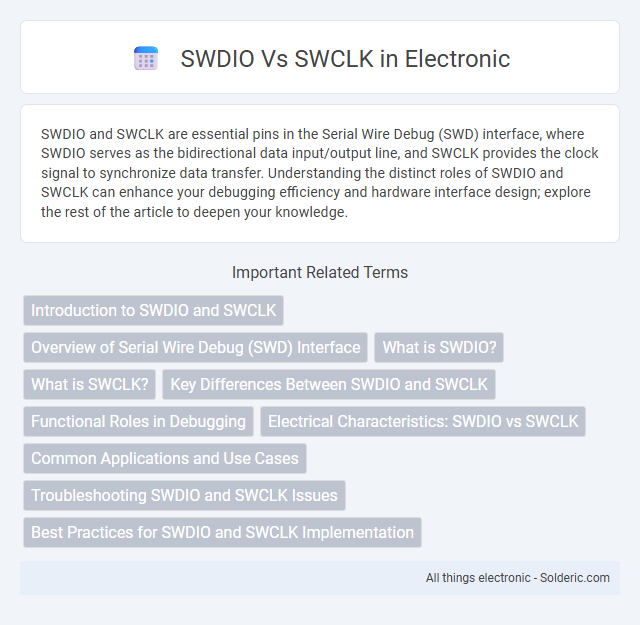SWDIO and SWCLK are essential pins in the Serial Wire Debug (SWD) interface, where SWDIO serves as the bidirectional data input/output line, and SWCLK provides the clock signal to synchronize data transfer. Understanding the distinct roles of SWDIO and SWCLK can enhance your debugging efficiency and hardware interface design; explore the rest of the article to deepen your knowledge.
Comparison Table
| Feature | SWDIO (Serial Wire Debug I/O) | SWCLK (Serial Wire Clock) |
|---|---|---|
| Function | Data input/output line for SWD communication | Clock signal line for synchronizing SWD data transfer |
| Signal Type | Bidirectional data line | Unidirectional clock signal |
| Role in Debug Interface | Transfers commands, responses, and debug data | Generates clock pulses to time data transfers |
| Electrical Characteristics | Open-drain or push-pull depending on implementation | Push-pull output, strong clock drive |
| Protocol | Part of ARM Serial Wire Debug (SWD) protocol | Part of ARM Serial Wire Debug (SWD) protocol |
| Number of Lines | Single bidirectional line | Single unidirectional line |
| Purpose | Data communication between debugger and target | Controls timing for data exchange |
Introduction to SWDIO and SWCLK
SWDIO (Serial Wire Debug Input/Output) and SWCLK (Serial Wire Clock) are fundamental pins in the ARM Serial Wire Debug (SWD) interface, used for efficient debugging and programming of microcontrollers. SWDIO serves as a bidirectional data line for transferring commands and data between the debugger and the target device, while SWCLK provides the clock signal that synchronizes data exchange on the SWDIO line. Your understanding of the roles of SWDIO and SWCLK is essential for successful hardware debugging and real-time microcontroller communication.
Overview of Serial Wire Debug (SWD) Interface
Serial Wire Debug (SWD) interface utilizes two primary signals: SWDIO and SWCLK, to facilitate efficient debugging of embedded systems. SWDIO serves as a bidirectional data line for transferring instructions and data between the debugger and the target device, while SWCLK provides the clock signal that synchronizes data transmission. This reduced-pin interface offers a compact and streamlined alternative to traditional JTAG debugging, enabling faster communication and lower pin count requirements in ARM Cortex-M microcontrollers.
What is SWDIO?
SWDIO (Serial Wire Debug Input/Output) is a bidirectional data line used in the Serial Wire Debug (SWD) interface, facilitating communication between a debugger and a microcontroller. It transmits data, commands, and responses in a half-duplex manner, enabling efficient debugging and programming of ARM Cortex-M processors. Unlike SWCLK, which provides the clock signal, SWDIO carries the actual debug data, making it crucial for real-time control and data exchange during debugging sessions.
What is SWCLK?
SWCLK (Serial Wire Clock) is a crucial signal in the ARM Serial Wire Debug (SWD) interface used for synchronous communication between a debugger and a target microcontroller. It provides the clock pulses necessary to synchronize data transfer on the SWDIO line, ensuring accurate data exchange during programming and debugging. Understanding SWCLK helps optimize your debugging setup by maintaining signal integrity and timing accuracy.
Key Differences Between SWDIO and SWCLK
SWDIO (Single Wire Debug Input/Output) serves as a bidirectional data line for communication between the debugger and the target device, while SWCLK (Single Wire Debug Clock) provides the timing signal that synchronizes data exchange during debugging. SWDIO carries both command and response data, making it essential for transferring debug instructions and read/write operations, whereas SWCLK ensures proper timing and coordination of these data transfers. Understanding the distinction between SWDIO's data role and SWCLK's clock role is crucial for effective debugging and programming of microcontrollers using the SWD protocol.
Functional Roles in Debugging
SWDIO (Serial Wire Debug Input/Output) serves as the bidirectional data line in the Serial Wire Debug (SWD) interface, facilitating data transfer between the debugger and the target device. SWCLK (Serial Wire Clock) provides the clock signal that synchronizes data communication on the SWD bus, ensuring precise timing for command and data exchanges. Together, SWDIO and SWCLK enable efficient, low-pin-count debugging and programming of ARM Cortex-M microcontrollers by managing data flow and timing control.
Electrical Characteristics: SWDIO vs SWCLK
SWDIO and SWCLK exhibit distinct electrical characteristics critical for Serial Wire Debug (SWD) interface reliability. SWDIO operates as a bidirectional data line with input and output driver requirements, typically featuring pull-up or pull-down resistors to ensure defined logic levels and prevent floating states. In contrast, SWCLK serves as a unidirectional clock signal output from the debugger, demanding precise timing control and well-defined voltage levels to synchronize data transfer without signal integrity degradation.
Common Applications and Use Cases
SWDIO and SWCLK are essential signals in the Serial Wire Debug (SWD) interface primarily used for programming and debugging ARM Cortex-M microcontrollers. SWDIO serves as the bidirectional data line for transmitting instructions and data, while SWCLK provides the clock signal that synchronizes data transfer. Common applications include in-system debugging, firmware development, and real-time trace in embedded systems where low pin count and high efficiency are crucial.
Troubleshooting SWDIO and SWCLK Issues
Troubleshooting SWDIO and SWCLK issues often involves verifying signal integrity and proper pin connections on the debug interface. Common problems include incorrect pull-up resistors on SWDIO or faulty clock signals on SWCLK, causing failure in device communication or programming. Using an oscilloscope or logic analyzer to monitor SWDIO data transitions and SWCLK timing can identify signal anomalies and help resolve clock synchronization errors.
Best Practices for SWDIO and SWCLK Implementation
For best practices in SWDIO and SWCLK implementation, ensure SWDIO lines are properly terminated with pull-up resistors to maintain signal integrity, while SWCLK should have minimal trace length to reduce clock skew and noise. Use controlled impedance PCB traces and place decoupling capacitors close to the target device to stabilize voltage levels. Your design benefits from separating SWDIO and SWCLK paths to prevent crosstalk, enhancing debugging reliability and communication efficiency.
SWDIO vs SWCLK Infographic

 solderic.com
solderic.com